ARCHEO TOUR
Today we propose the Roman archaeological tour, which includes the Coliseum, the Arch of Constantine, the Forum of Nerva, that of Augustus, Trajan's Forum, Trajan's Column and the Forum of Caesar.
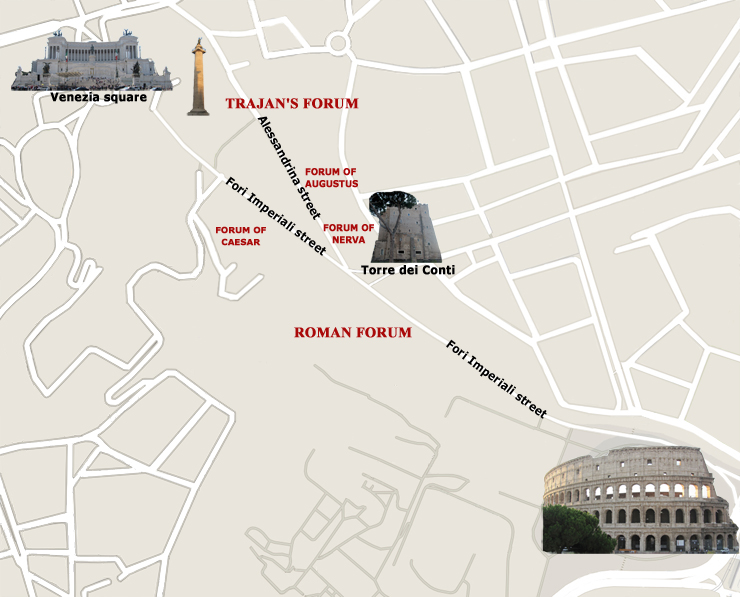
It is a popular route, but nevertheless we are confident to make you discover something new and interesting.
 The Coliseum, with over 6 million visitors a year, it is by far the most visited site in Italy and Fori Imperiali (=Imperial Forums) street, connecting the Coliseum to Venezia square, is the most touristic way of the city. The Coliseum, with over 6 million visitors a year, it is by far the most visited site in Italy and Fori Imperiali (=Imperial Forums) street, connecting the Coliseum to Venezia square, is the most touristic way of the city.
Returning to the Coliseum you can see that the four orders, namely the four plans, in the façade are different from one another, in fact the half-columns of the first order are Tuscan those of the second Ionic; those of the third Corinthian and still are Corinthian the pilasters of the fourth order.
In the blocks of travertine you can see the holes left by the metal clamps that held them still, removed in the Middle Ages.
In the middle of the fourth order are the 240 shelves,
on which rested as many vertical wooden beams supporting the curtain, extended to protect spectators from the sun.
In the cornice were drilled holes to pass the beams.
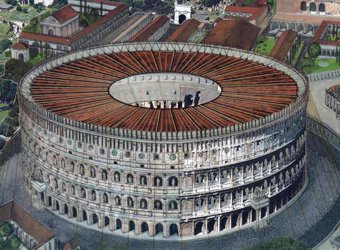 |
| The curtain |
The curtain, which was manipulated by the sailors of the Roman fleet, it was offset thanks to 150 stones, fixed in the ground about ten meters from the perimeter of the façade, on which were anchored ropes descending from the summit. Today there are 5 stones placed to the east, that is, on the opposite side as to Fori Imperiali street.
Next to the Colosseum it was built the wonder that is the Arch of Constantine.
Going towards Venezia square, further on the traffic lights at Largo Corrado Ricci, on your right hand starts Alexandrina street, built in the mid 1500 by Cardinal Michele Bonelli, nephew of Pope Pius V, who was born in Alexandria, and in his honor the street was named Alexandrina. At the very beginning of the street you can see part of the Forum of Nerva that actually was built by Domitian (Emperor from 81 to 96 a.C.), but he did not have time to inaugurate the Forum, since shortly before was assassinated.
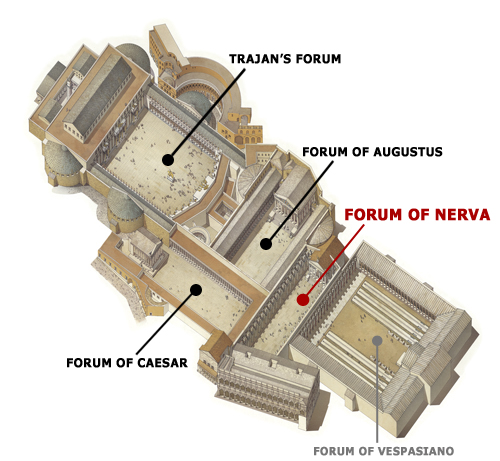
The Forum is also called “Transitorium” (=passage), because it connected the Roman Forum with the road that, through the popular neighborhood of Suburra, reached the Esquilina gate,
where today, not far from Santa Maria Maggiore, we see the arch of Emperor Licinius Gallienus. This Forum for its particular form, narrow and long, 45 meters to 120, unlike previous Forums, was built without porches, but the architect of Domitian came up with an ingenious solution, drawing a colonnade near the walls of the long sides. Above the colonnade ran a entablature and still higher the attic was decorated with reliefs depicting the provinces of Rome, alternating with gods.
On the short side not far from the Suburra there was the temple of Minerva, which, though time-worn, had resisted until 1605, when Pope Paolo V Borghese tore it down for removing the marbles, which he used in the construction of the fountain named Acqua Paola (=Paulus aqueduct).
In addition, around 1930, the building of Empire street, partly coinciding with Fori Imperiali street, caused the planting of a large part of the square of the Forum, which is now split into 2 parts, the greater close to Suburra, the smaller adjoining the Roman Forum. Of all the rich decoration today we can see the famous Colonnacce (=Columns), which also suggest what was the splendor of the colonnade, recalling that the perimeter wall, of tuff, it was covered with slabs of white marble from Luni, namely Carrara.
Continuing along via Alexandrina you meet the Forum of Augustus, the second of the Imperial Forums to be built.
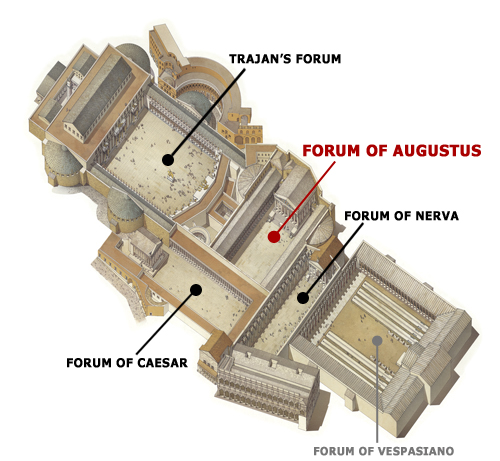
At the center of the Forum on a high podium stood
the Temple of Mars Ultor (=Avenger), inaugurated by Augustus to commemorate the Battle of Philippi in 42. C. in which, together with Mark Antony, he defeated Caesar's assassins, who then was avenged. Today you can see the 17 steps leading to the atrium of the temple, that on the facade had 8 columns, of which remain the foundation and 4 of them have been partially raised. While survived the lateral columns on the end, supporting a section of the entablature (made up of architrave, frieze and cornice). In the Middle Ages in the cell of the temple it was accommodated the church of St. Basil and nearby the monastery of Santissima Annunziata, both were accessed by the Suburra.
Traces of the roofs of the church and convent can be seen on the end wall. The imposing wall, 30 meters high, was made of a variety of tuff particularly resistant to fires that inevitably flared up in Suburra. The wall was covered with white marble slabs. The temple of Mars was built with no expense spared, in the Museum of the Imperial Forums, one can see many refined artifacts,
among which a golden foot belonging to one of two goddess of victory that were on the pediment of the temple.
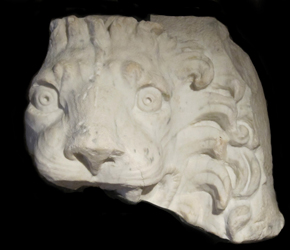 |
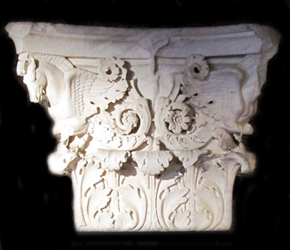 |
| The artifacts |
The square of the Forum was surrounded by arcades, inside there were 4 exedras, 2 of them, already at the time of Trajan were demolished.
The 2 exedras survived are clearly visible, as well as the rich floor of the porch and exedras. On the ground you can see trunks of columns and other artifacts which testify to the wealth and variety of marble used, while the square of the Forum was paved with slabs of white marble from Luni.
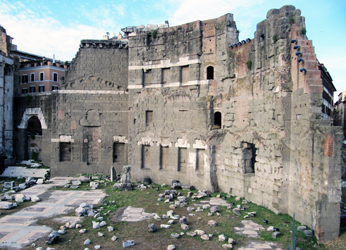 |
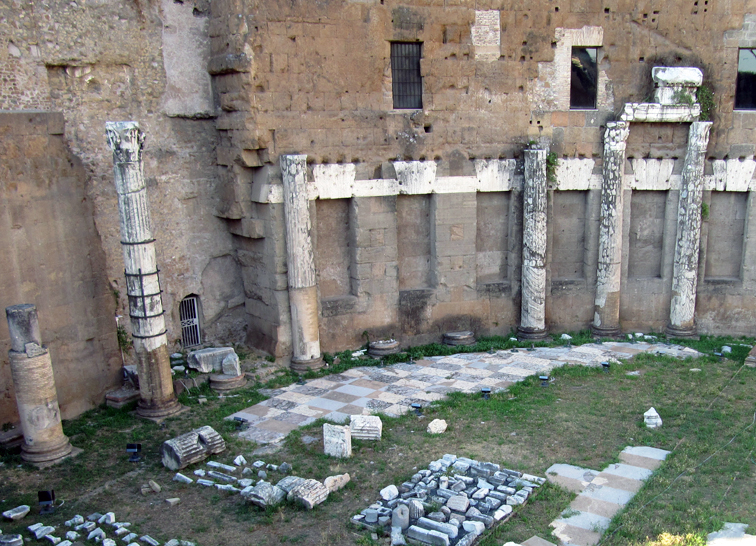 |
| The two exedras |
From the Forum of Augustus comes the gigantic statue, which is located in the atrium of the Palazzo Nuovo of the Capitoline Museums, named Marforio, or Forum of Mars, since the Romans renamed, the Forum of Augustus, Forum of Mars, for the presence of the homonymous temple.
To be continued...
back |

